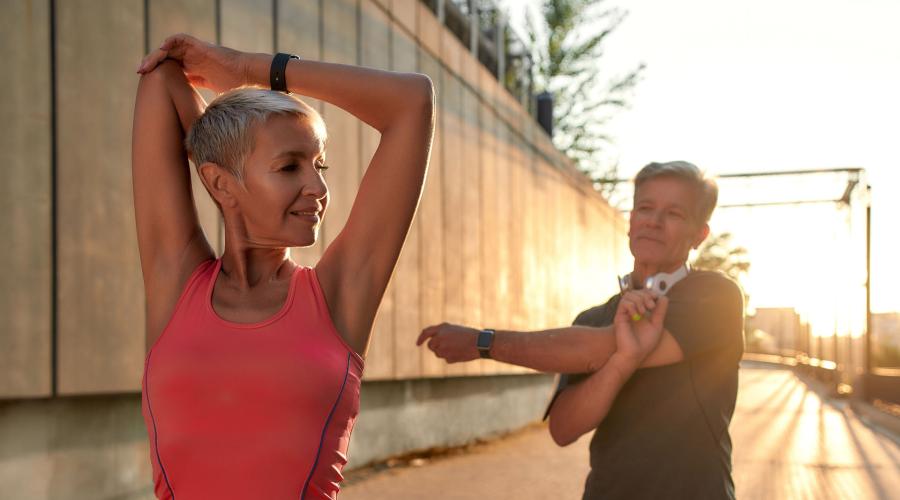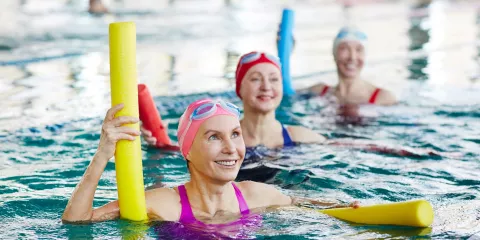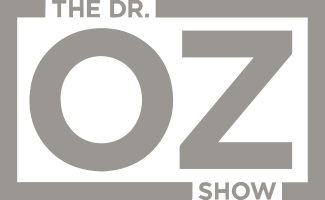
Regular exercise has been shown to increase lifespan, strengthen bones and muscles, reduce disease, and even improve brain health1 — yet exercising too hard can leave you feeling sore and exhausted.
Follow these 6 simple guidelines to avoid injury and restore energy levels after a rigorous workout.
1. Incorporate a Cool Down Into Your Exercise Routine
When you finish your workout, start with a cool down while your muscles are still warm. A simple five-minute walk will help your heart rate and body temperature return to normal, which can reduce feelings of lightheadedness or dizziness.
Adding stretching to your post-workout routine can increase flexibility and range of motion — and some athletes also report a reduction in pain and muscle stiffness.2 For ideas for simple cool down exercises, including a customized cooldown routine for seniors, try this handy guide from Healthline.
2. Rehydrate After Exercise
It’s important to hydrate after a workout, especially if you worked up a sweat. During an intense workout, you can sweat out 1 to 4% of your body weight every hour, and you’ll want to replace those liquids to protect against dehydration.3
Water is always a good go-to, but you can also try drinks such as coconut water, tea, protein-rich chocolate milk, or low-sugar sports drinks that contain electrolytes that have been shown to relieve muscle cramping. Other foods and beverages that contain electrolytes include bananas, milk, watermelon, orange juice, and even pickle juice!4
3. Eat a Healthy Snack
Aim to eat a healthy snack within 45 minutes of completing your workout, especially if you’re engaged in endurance sports or are trying to build muscle. This will help refuel your body’s stores of glycogen, the main fuel source used during long bouts of aerobic exercise.5
Stock your kitchen with healthy proteins like dairy, eggs, lean meat, fish, nuts, and quality protein bars. In addition to protein shakes, healthy carbs like whole grain pasta, oatmeal, fresh fruit, sweet potato, whole wheat bread, quinoa, and legumes are also great for a quick energy boost.
Read More: Heart Healthy Recipes & Snacks
4. Get a Massage or Take a Bath To Ease Sore Muscles
Sometimes the best thing you can do after a workout is to indulge yourself. Try taking a relaxing hot bath with Epsom salts, getting a massage, or using a foam roller on aching muscles.
In addition to relieving soreness and helping lower stress levels, a 2015 study found that massage increases the percentage of regenerating muscle fibers. Just don’t wait too long to treat yourself — the same study found massage had the most impact when done immediately after exercise.6
Can Hot/Cold Therapy Help Sore Muscles?
Many athletes swear by ice baths and contrast water therapy (alternating hot and cold showers) to reduce muscle soreness and speed recovery — but there are a few things you should know about this kind of therapy.
Hot therapy has been shown to reduce joint stiffness and muscle spasm, helping relax tight muscles. Meanwhile, cold therapy (also called Cryotherapy) can ease pain while reducing swelling and inflammation.7
Despite its popularity, it should be noted that icing has its detractors. According to physician Gabe Mirkin, who once helped popularize cold therapy’s use as part of the RICE (rest, ice, compression, elevation) method, new evidence suggests that inflammation is in fact your body’s way of healing. Mirkin cautions that icing can delay this healing response.8
When in doubt, be sure to take cues from your body — and don’t be afraid to take a day or two to let your body rest (more on that below).
5. Try Light Exercise on Your Day Off
Not every workout needs to be super intense — in fact, it’s a good idea to alternate high-intensity workouts with gentler recovery workouts. Whether its walking, swimming, yoga, or other forms of low-impact exercise, research suggests that lower-intensity exercise is the most effective way to recover from sore muscles, or DOMS (Delayed Onset Muscle Soreness).9
As a general rule of thumb, aim to have 24-72 hours rest between rigorous training sessions involving the same body parts. Your ideal recovery period could extend from a day, for a regular workout, to up to a week when recovering from a 10K race, according to the American Council on Exercise (ACE) Scientific Advisory Panel.
Recovery Tip For Older Athletes:
Research from the UC Berkeley School of Public Health suggests that older muscles take longer to recover after heavy exercise. If you’re feeling sore from a tennis match, skiing, weight lifting, running or other form of intensive exercise, it’s okay to take a day or two to enjoy a walk in the park or leisurely bike ride!
6. Rest Your Body and Mind
Did you know your body produces its own muscle-building hormones while you sleep, including human growth hormone?
During NREM (non-rapid eye movement) sleep, blood flow to your muscles increases and tissue growth and repair occurs. During REM sleep the muscles relax, which can help sore muscles recover.10 Getting quality sleep each night, or even taking a short power nap during the afternoon, can aid muscle recovery.
Managing stress levels is equally important. Try meditation, yin yoga, breathing techniques, a hike in nature — or even just listening to relaxing music. A 2016 study published in the Journal of Sports Medicine and Physical Fitness found that listening to slow-tempo songs following exercise can help reduce your heart rate and get your blood lactate (an indirect marker for fatigue) back down to resting levels more quickly.11
And remember, pushing yourself too hard can lead to strain or injury. Whatever recovery or exercise routine you choose, listen to your body’s signals to ensure you are fully rested between workouts — and ready for the next challenge.
References
1 https://www.cdc.gov/physicalactivity/basics/pa-health/index.htm
2 https://www.heart.org/en/healthy-living/fitness/fitness-basics/warm-up-cool-down
3 https://www.prevention.com/fitness/fitness-tips/a20428237/how-to-stay-hydrated-after-your-workout//
4 https://www.webmd.com/pain-management/ss/slideshow-muscle-cramps-foods
5 https://www.todaysdietitian.com/newarchives/110413p18.shtml
6 https://www.healthline.com/health-news/massage-can-boost-effectiveness-of-workouts#3.-Preventing-injury
7 https://www.hopkinsmedicine.org/health/treatment-tests-and-therapies/ice-packs-vs-warm-compresses-for-pain
8 https://www.washingtonpost.com/national/health-science/athletes-love-icing-sore-muscles-but-that-cold-therapy-might-make-things-worse/2019/01/31/a465dd84-1f25-11e9-8e21-59a09ff1e2a1_story.html
9 https://pubmed.ncbi.nlm.nih.gov/12617692/
10 https://www.sleep.org/how-sleep-adds-muscle/
11 https://pubmed.ncbi.nlm.nih.gov/27314136/












